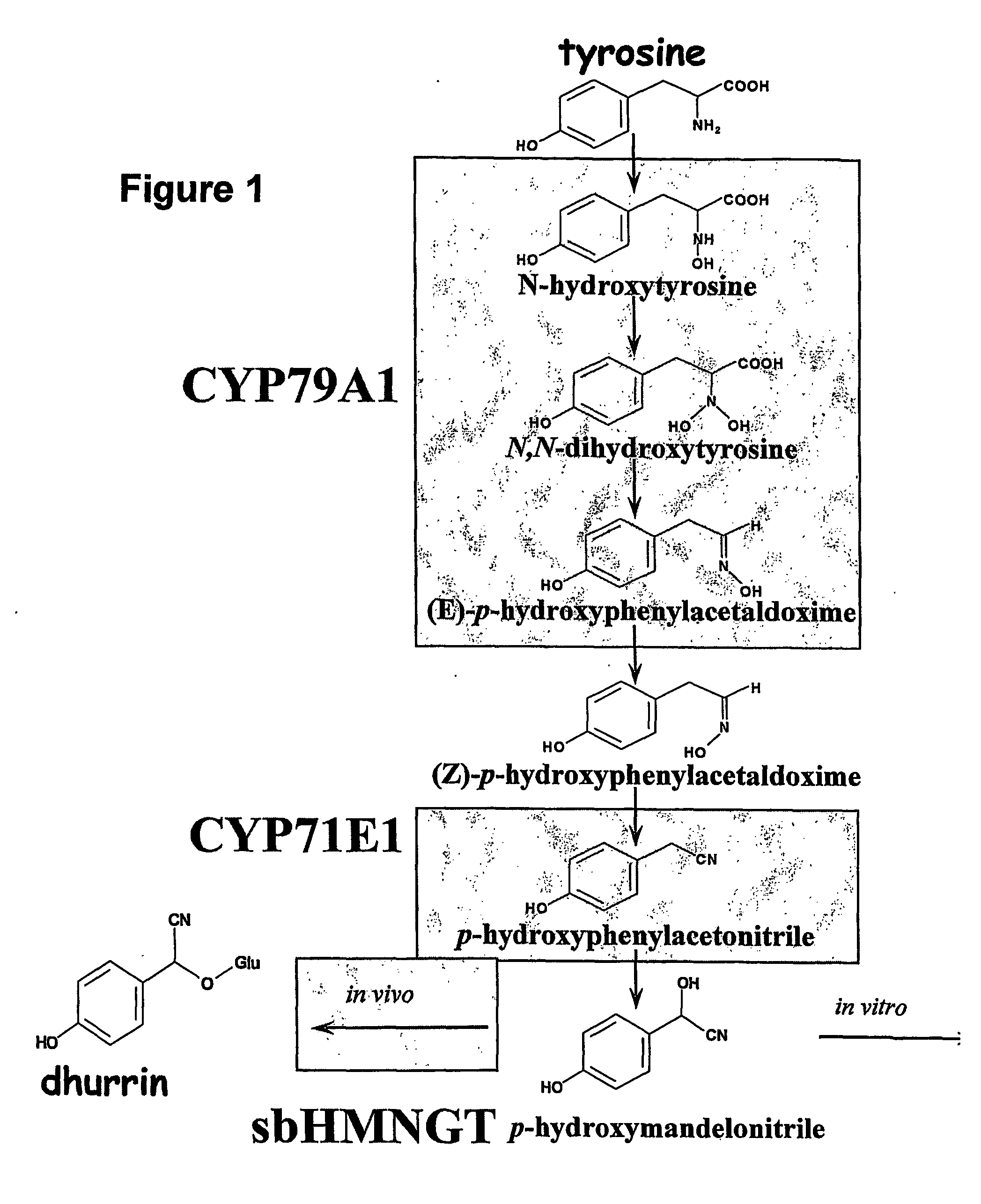Method of producing a low molecular weight organic compound in a cell
a low molecular weight, cell technology, applied in the direction of transferases, instruments, food preparation, etc., can solve the problems of difficult and inefficient extraction, virtually impossible to synthesize at economic levels, and difficult to extra
- Summary
- Abstract
- Description
- Claims
- Application Information
AI Technical Summary
Benefits of technology
Problems solved by technology
Method used
Image
Examples
example 1
Analysis of Increased Tolerance to Vanillin in Microorganisms Expressing a UDPG-Glucosyl Transferase
[0236] Vanillin sensitivity is determined in a number of microorganisms. The microorganisms includes the Escherichia coli strains DH5-alpha, TOP10, JM109 and K01418; the Pseudomonasfluorescens strains DSM 50091, DSM 50108 and DSM 50124; the Bacillus subtilis strain DSM 704; and the Corynebacterium glutamicum strain DSM 20300. The microorganisms also include strains of Saccharomyces cerevisiae, S. uvarum, S. bayanus, S. paradoxus, S. kudriavzevii, S. mikatae, S. cariocanus, S. servazzii, S. castellii, S. kluyverii, Kluyveromyces lactis, Zygosaccharomycesfermentatii, Torulaspora delbruekii, Debaromyces orientalis and Schizosaccharomyces pombe.
[0237] The minimum inhibitory concentration of vanillin is determined by the two-fold serial dilution assay (Hufford et al, 1975, J Pharm Sci 4: 789). Furthermore, the concentration of vanillin necessary to inhibit growth by more than 50% is dete...
example 2
Identification of Glucosides in Microorganisms Expressing a UDPG-Glucosyl Transferase
[0241] Microorganisms expressing a heterologous UDPG-glucosyl transferase are grown in medium containing appropriate levels of vanillin or ethylvanillin. The microorganisms are harvested and their content of glucosides is extracted in methanol or other suitable solvents. The presence of vanillin glucoside or ethylvanillin glucoside will be established and their levels will be quantified. The content of vanillin glucoside and ethylvanillin glucoside are compared in transgenic and non-transgenic microorganisms as well as in microorganisms grown in medium with and without vanillin or ethylvanillin.
[0242] The presence of increased amounts of vanillin glucoside or ethylvanillin glucoside in UDPG-glucosyl transferase expressing microorganisms grown in medium containing vanillin or ethylvanillin indicates that the aglucones are taken up and glucosylated by the transgenic organism.
example 3
Increased Uptake and Turnover of ferulic Acid in Microorganisms Expressing a UDPG-Glucosyl Transferase
[0243] Microorganisms capable of converting ferulic acid into vanillin are genetically modified to express a heterologous UDPG-glucosyl transferase. Streptomyces setonii strain ATCC 39116 is used for these studies since it has previously been employed for industrial production of vanillin from ferulic acid (Muheim & Lerch, 1999, Appl Microbiol Biotechnol 51: 456; Muheim et al, 1998, EP 0885968A1). Alternatively, Pseudomonas putida strain AN103 (Narbad & Gasson, 1998, Microbiol 144: 1397; Narbad et al, 1997, WO 97 / 35999), or Amycolatopsis sp. HR167 (Rabenhorst & Hopp, 1997, EP 0761817A2) are used. The microorganisms are transformed with the appropriate construct so as to express Sorghum bicolor UDPG-glucosyl transferase UGT85B1, Arabidopsis thaliana UDPG-glucosyl transferase UGT89B1 or Rauvolfia serpentina arbutin synthase.
[0244] The genetically modified microorganisms are grown in...
PUM
| Property | Measurement | Unit |
|---|---|---|
| Molecular weight | aaaaa | aaaaa |
| Weight | aaaaa | aaaaa |
Abstract
Description
Claims
Application Information
 Login to View More
Login to View More - R&D
- Intellectual Property
- Life Sciences
- Materials
- Tech Scout
- Unparalleled Data Quality
- Higher Quality Content
- 60% Fewer Hallucinations
Browse by: Latest US Patents, China's latest patents, Technical Efficacy Thesaurus, Application Domain, Technology Topic, Popular Technical Reports.
© 2025 PatSnap. All rights reserved.Legal|Privacy policy|Modern Slavery Act Transparency Statement|Sitemap|About US| Contact US: help@patsnap.com

